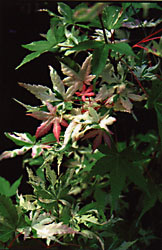 |
 |
 |
 |
 |
Long ago in the country of Japan lived an emperor named Takakura no In. He loved all of nature and was especially fond of maple trees. Their incredible variation both fascinated and enchanted him, and their beauty soothed him. The emperor's home was in the country; his palace was on a mountain top. For his pleasure, Takakura no In ordered his people to search for as many different maples as they could find and to plant these treasures all over the mountain.
One fall evening a new gardener worked very hard and very late on the mountain. It was cold but the work kept him warm. Eventually, his family began to help out. It would make a good impression on the emperor to see so much cleaning and raking; besides, they too were cold. But, finally, it got too dark to work and by then it was even colder. The gardener started a little fire and began to burn the leaves. It was lovely for the children to warm their feet in the double red of flame and autumn leaf. The farmer also heated some rice for all and some wine for his wife and himself. Before dawn, at the night's coldest hour, he arose, raked and burned those leaves which had blown down while they rested. Comforted, his family slept on peacefully. The samurai, the emperor's generals, were the first to stir that morning. When they saw what the new gardener had done they became alarmed for his safety. They knew what this man did not: the emperor began his fall days contemplating the beauty of pink, gold, blue, orange, maroon and scarlet leaves that had fallen on the ground. All year he anticipated these days; Takakura no In planned his life so he would be home on his mountain at this time. The samurai did not know what to do. They could be vicious warriors when defending their emperor, but they were also men of great compassion and did not want to see this lead to tragedy. While they worried, the emperor, unseen, arrived on the mountain top, ready to savor the morning's colorful beauty. The samurai looked up in time to see a loving smile touch his cheeks. The emperor saw and understood immediately what had occurred. Contrary to the fears of the samurai, he was thrilled. He recited the verse of the famous poet, RI-Tai-Ha-Ku:
Later he wrote his own poem about the double gift of the leaves: first their beauty to nurture the human spirit and then their warmth to nurture physical bodies. The story of Takakura no In is rewritten from various accounts. Japanese Gardens by Mrs. Basil Taylor; Dodd, Mead & Company, New York, 1912 is one. Photo: Acer palmatum (green) and Acer palmatum atropurpureum |
 |
|||
|
Eastwoods Nurseries 634 Long Mountain Road Washington, VA 22747 540-675-1234 maples@japanesemaples.com © Eastwoods Nurseries 2021, all rights reserved. |
|||||
